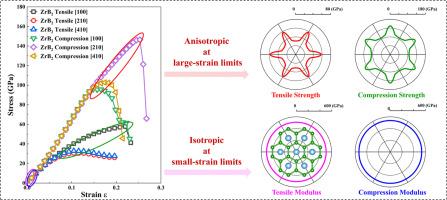Setting material benchmarks at large-strain limits via ultimate strengths
IF 8.3
1区 材料科学
Q1 MATERIALS SCIENCE, MULTIDISCIPLINARY
引用次数: 0
Abstract
Structural stability and durability are two foundational attributes underpinning all material functionalities, yet traditional approach only sets stability criteria in terms of elastic parameters derived at small strains, then extends their use to probing strength and durability at large strains via empirical relations due to a lack of accurate material benchmarks at strong deformation. Such extrapolations, however, may cause major quantitative or even qualitative deviations in assessing material behaviors at large strains when the elastic parameters fail to capture distinct underlying physics under strong deformations. Here, we introduce ultimate strengths, defined by peak stresses on diverse deformation paths from first-principles calculations, to set accurate and robust benchmarks for assessing materials at large-strain limits. We take transition-metal diborides as an exemplary class of materials to showcase strong directional anisotropy and load dependence of stress responses at large strains, in sharp contrast to the behaviors predicted by elastic parameters. We elucidate the impact and mechanism of load-constrained deformation, bond charge distribution, and electronic band structure on mechanical responses at elastic or dynamic stability limits. This work fulfills a longstanding need in materials science to set robust and accurate benchmarks that are tailored as explicit descriptors for key material characteristics under strong deformations.


通过极限强度在大应变极限下设定材料基准
结构稳定性和耐久性是支撑所有材料功能的两个基本属性,然而传统方法仅根据在小应变下导出的弹性参数设置稳定性标准,然后由于缺乏准确的材料在强变形下的基准,通过经验关系将其扩展到在大应变下探测强度和耐久性。然而,当弹性参数无法捕捉到强变形下不同的底层物理时,这种外推可能会导致在大应变下评估材料行为时产生重大的定量甚至定性偏差。在这里,我们引入了极限强度,由来自第一性原理计算的不同变形路径上的峰值应力定义,为评估大应变极限下的材料设定了准确而稳健的基准。我们以过渡金属二硼化物为例,展示了在大应变下应力响应的强方向各向异性和载荷依赖性,与弹性参数预测的行为形成鲜明对比。我们阐明了载荷约束变形、键电荷分布和电子能带结构对弹性或动态稳定极限下机械响应的影响和机制。这项工作满足了材料科学长期以来的需求,即设置强大而准确的基准,这些基准可作为强变形下关键材料特性的明确描述符。
本文章由计算机程序翻译,如有差异,请以英文原文为准。
求助全文
约1分钟内获得全文
求助全文
来源期刊

Acta Materialia
工程技术-材料科学:综合
CiteScore
16.10
自引率
8.50%
发文量
801
审稿时长
53 days
期刊介绍:
Acta Materialia serves as a platform for publishing full-length, original papers and commissioned overviews that contribute to a profound understanding of the correlation between the processing, structure, and properties of inorganic materials. The journal seeks papers with high impact potential or those that significantly propel the field forward. The scope includes the atomic and molecular arrangements, chemical and electronic structures, and microstructure of materials, focusing on their mechanical or functional behavior across all length scales, including nanostructures.
 求助内容:
求助内容: 应助结果提醒方式:
应助结果提醒方式:


